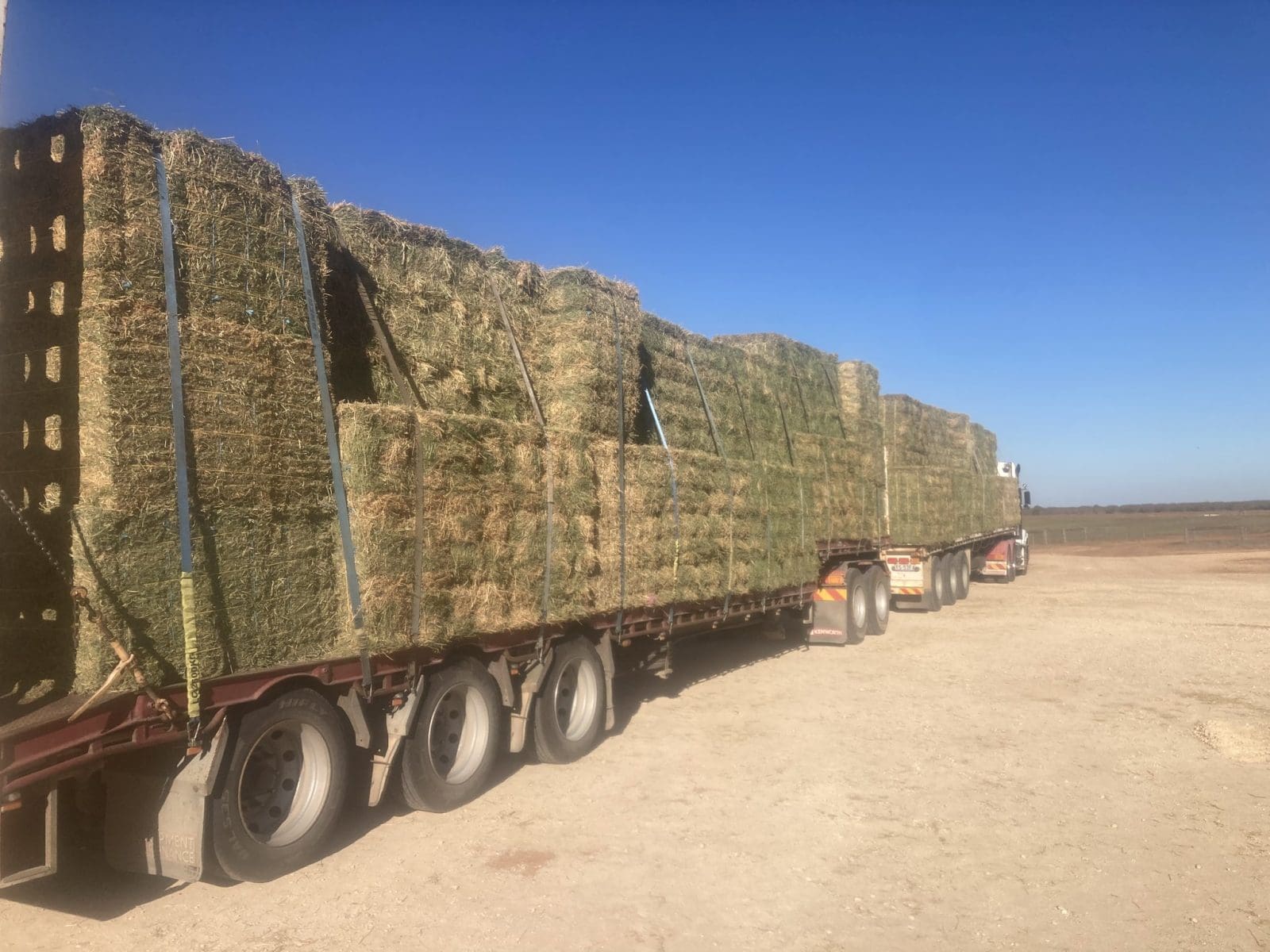
A load of hay arrives in SA, one of many heading into drought-affected parts of south-eastern Australia after an extremely dry autumn to date, and what for many has been the driest 15 months on record. Photo: James Stacey
A SLOWDOWN in wheat and barley exports coupled with up-country out-turn from bulk handlers as well as farmers has allowed the southern market to soften, despite ongoing dry conditions.
Consolidating prospects for rain over south-eastern Australia has added to the south’s softer tone, while in the north, barley has firmed as growers remain preoccupied with out-turning sorghum and planting wheat.
Drought conditions across southern NSW, western and central Victoria as well as Gippsland, and South Australia are prompting mixed farmers and graziers to buy in roughage as well as grain.
However, larger domestic consumers are seen as well covered, although shorts have been appearing in the northern and southern markets.
| Prompt May 15 | Prompt today | New-crop today | |
| Barley Downs | $334 | $340 | $345 Jan |
| ASW Downs | $353 | $350 | $356 Jan |
| Sorghum Downs | $353 | $355 | NQ |
| Barley Mel | $382 | $375 | NQ |
| ASW Mel | $385 | $385 | NQ |
Table 1: Indicative prices in Australian dollars per tonne.
North busy planting
In Narrabri, Agvantage Commodities broker Brendon Warnock said periods of rain and then dry have allowed growers to plant on schedule, although some on the black-soil plains have had to pause to allow ground to dry out enough to carry machinery.
“Progress has been pretty good, although…some western areas have been a challenge with the wet conditions,” Mr Warnock said.
“Establishment of early crops like wheat, faba beans and canola has been good.”
Mr Warnock said growers in the region were generally waiting until June to plant chickpeas in order to minimise the risk of getting hit with frost at flowering.
“Sorghum is pretty well wrapped up, and it’s trading at a premium to APH2 (wheat), so people have been incentivised to move it quickly.”
Torrential rain which is flooding towns and beef cattle and dairy farms from the Hunter Valley to the North Coast of NSW has also hampered deliveries to export and domestic sites in recent days.
The deluge will also up short-term demand for hay in NSW, which is currently selling into the state’s south, and Vic and SA, to counter drought conditions.
Mr Warnock said selling of winter cereals has been limited.
“Wheat and barley prices are not exciting the farmers too much; they’re right on the edge of profitability at these levels.
“People are seeing dryness in the south, and issues in the Northern Hemisphere, and some green shoots for wheat getting a short-covering rally.
“Although this current crop is looking pretty secure, there’ll be a steady offering between now and harvest time.
“Prices can’t afford to drop dramatically; growers are strong holders.”
Mr Warnock said some drought-feeding inquiry for barley was filtering through, and pulling loads from as far north as Gilgandra.
“As those stocks get exhausted, there will be a creep north.”
On sorghum, bulk exports have slowed, and demand is contracting to the container market, although the last loads to fill the final ships out of Brisbane are still trading delivered port at around $378/t.
“I think there’ll be enough container demand to suck up what’s left on the sorghum,” one trader said.
The trader said big stocks of wheat and barley in warehousing and on farm would prevent a major rally driven by dry conditions in the south.
“Some growers are sitting on tens of thousands of tonnes.”
Sorghum deliveries to the Central Qld port of Mackay have started recently at around $365/t.
On cottonseed, Woodside Commodities managing director Hamish Steele-Park said values were firmer in southern NSW’s Riverina region because of the dry weather, but rangebound in the north.
Gwydir Valley ex-gin cottonseed is quoted at around $415/t, $30/t under the Riverina market.
“Buying interest is mainly domestic players; the export market remains subdued,” Mr Steele-Park said.
“US seed remains cheaper on a CFR basis into Japan and Korea than Australian seed by around US$20/t.
“However, China is still the main buyer for Australian seed and won’t take US seed due to tariffs etc.”
Mr Steele-Park said Chinese demand will be key to the cottonseed market’s future direction.
South chases roughage
A shortage of roughage has emerged as an issue for smaller enterprises with cattle and sheep to feed in a dry or droughted area which now spreads from the dairying country of Vic’s Gippsland to central NSW to SA’s western Eyre Peninsula.
Helping to fill the gap are almond hulls and baled straw from irrigated wheat and rice crops.
At Barooga on the NSW-Vic border, Sefton Agronomics principal Greg Sefton said his clients “very good reserves of fodder” were dwindling.
“Something quite significant we’ve seen in the past two weeks is that clients are now baling wheat straw, and rice stubble…to go into rations,” Mr Sefton said.
Straw yields for wheat are around 2-2.5t/ha, and it is selling at around $200/t, and baling it has become a profitable alternative to burning prior to the next sowing.
As with last year, recently harvested corn in the Murray Valley and surrounds is making its way into sheep and cattle rations beyond the usual winter dairy demand.
“We’ve got growers selling maize into Victoria, and that market’s jumped $50/t in the past week.”
A benchmark price for the yellow grain is around $400/t, plus $45/t delivery to the Western District or Gippsland.
Mr Sefton said crops have been yielding a pleasing 18-20t/ha from early sowing, and 14-16t/ha grown over a shorter timeframe.
“Maize yields are up 10-15pc on last year.”
Growers, agronomists, and the trade have all stressed that dry-sown winter crops have another three weeks to see rain before the likelihood develops of a below-average production for south-eastern Australia.
However, the market is well aware that southern new-crop will attain critical mass in December, and not before, unless winter and spring produce the most favourable weather on record.
“There is some chat about wheat for new crop, but if anyone’s going to trade Oct-Nov, it’s going to be old crop,” Pinion Advisory broker Brad Knight said.
“It’s all spot market plus carry.”
Global cash markets are showing their usual inverse for August onward, when Northern Hemisphere new-crop volume is expected.
Mr Knight said dryness in Australia’s consumptive markets, including south-eastern Australian dairying areas, was muting a similar development.
Uninspiring bids from global wheat and barley markets coupled with the strengthened domestic demand means accumulation for bulk cargoes has dropped the pace.
“Exporters have slowed down a bit.”
Sources in northern and southern markets are confident that ample wheat and barley stocks exist in all states, even SA, to satisfy human-consumption and feed demand up to new crop.
As graziers and mixed farmers call on friends and relatives, and contacts through contacts, to source grain and roughage, bulk handlers including GrainCorp are also out-turning loads of grain to satisfy spot and regular demand.
“We’re always moving grain to support the domestic market, and that continues year-round,” a GrainCorp spokesperson said.
“Recently, we’ve seen a slight increase in grower out-loads in the southern states due to the dry conditions.
“GrainCorp operates a notional stock system, which means we manage grain availability across our network to meet the needs of both domestic and export customers.
“At times, this involves moving or swapping grain within the network to ensure growers and buyers can access their entitlements when and where they need them.”
Grain Central: Get our free news straight to your inbox – Click here

HAVE YOUR SAY